





Mountain avens are a familiar sight throughout the northern Rockies, the higher mountains of Europe and the Arctic regions. If you have ever traveled in these areas, you will have encountered these delicate yet tough alpines. If not, let me introduce you to these dwarf members of the rose family.
One of the keynote species of the north temperate alpine regions is mountain avens or Dryas. Anyone hiking in the high mountains of North American Rockies, European Alps or Caucasus, Russian Urals and even the slopes of Siberia and Alaska, are likely to encounter this plant. They are a dominant plant of the unique Irish Burrens, as well as the limestone barrens of Newfoundland. Mountain avens even make it well into the Arctic Circle, and in fact, grow as far north as there is land! The genus gets its name from the Greek oak-nymph called 'Dryas'. The genus name refers to the similarity of the leaves of mountain avens to those of oaks. Mountain avens belong to the rose family. Plants are woody and prostrate forming extensive mats that often root at intervals, lending this plant the effective ability to stabilize mountain slopes and river gravels. In mountainous regions, mountain avens typically grow on limestone substrates, but in the high Arctic they are not so restricted.
Their leaves are indeed shaped like miniature oak-leaves. They may be evergreen or at least semi-evergreen, which enables them to start growth as soon as the winter snows melt. Plants bloom within weeks of the melting snow, producing masses of solitary 1-2" diameter white, cream or yellow flowers. Their flowers often turn on their stems to follow the sun across the sky. Their flowers are saucer shaped and heat above the ambient air temperature when exposed to the sun. This makes them attractive to insects who like to 'hang-out' inside the warm blossoms. From the plant's perspective, this increases the chances of being pollinated. Developing seeds are plumed (feather-like) and give the attractive seedheads the appearance of a miniature pasque-flower.
There are only three species of Dryas along with two natural hybrids. The most wide-ranging species is the white mountain avens, Dryas octopetala, ranging from Greenland/Iceland, across Eurasia and into Alaska and south to Colorado. It is probably the showiest species and most amenable to cultivation. The flowers are the largest of the mountain avens with white to cream-tinted flowers. Each flower typically has 8 petals (hence 'octopetala',) a feature unusual in the rose family where 5 petals is the norm. Typically forms of this plant from Eurasia are larger in stature than their North American counterparts. Dryas octopetala is the National Flower of Iceland.
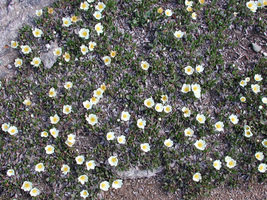
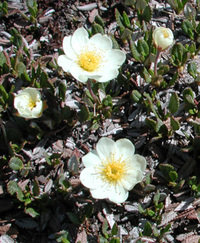
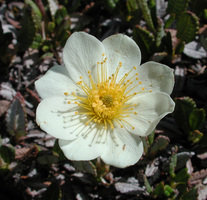
Details of D. octopetala with pics taken in the Alberta Rockies
This former species is absent from the central and eastern Canadian Arctic where it is replaced by a smaller species called the entire-leaf mountain avens, D. integrifolia. This species has smaller leaves and is semi-evergreen while D. octopetala is evergreen. The flowers are more distinctly cream-coloured. Otherwise, from a distance, the two species look quite similar. This species is the dominant species of the Newfoundland limestone barrens and is the Territorial Flower of Canada's Northwest Territory. It extends as far south as the White Mountain in New Hampshire.
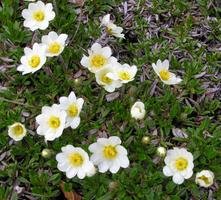
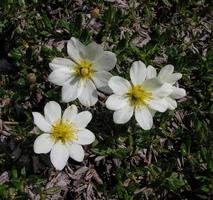
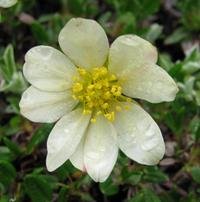
A collection of pictures of D. integrifolia, all taken in the wilds of Newfoundland
The yellow mountain avens, D. drummondii is only found in North America. This species is most common along the gravelly margins of large mountain and/or Arctic rivers of northwestern North America, from Alaska and the Yukon, south to Montana, Idaho and Oregon. It also occurs, in very limited numbers, upon limestone outcrops of Ontario, Quebec and Newfoundland. Presumably this species occurred across North America before the last glaciation but populations in the east were mostly wiped out by the glaciers, surviving on the highest mountain-tops of eastern Canada. The flowers are distinct, being yellow and nodding. The flower buds are covered in black hairs which allow them to warm above the ambient air temperature and thus bloom shortly after the snows melt.
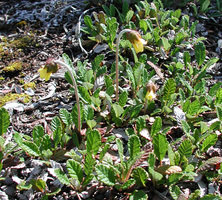
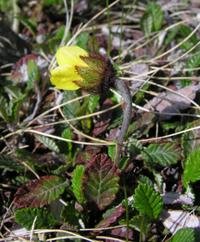
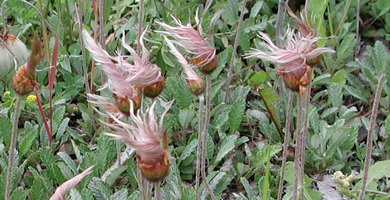
Details of D. drummondii, with pics taken in Glacier National Park, Alberta
There are also two naturally occurring Dryas hybrids. In Alberta exists D. X sundermannii, a hybrid between D. octopetala and D. drummondii, while in Quebec exists D. X wyssiana, the hybrid between D. integrifolia and D. drummondii. Both have the growth habit of D. drummondii with semi-nodding cream flowers reminiscent of the other parent.
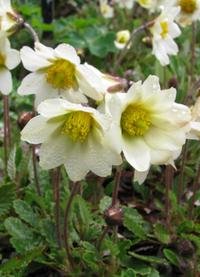
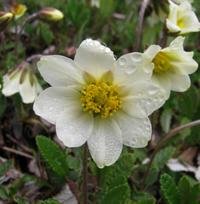
Details of the natural hybrid D. X sundermannii; this plant is growing in the Memorial University of Newfoundland Botanical Garden
Despite being a plant of cold regions, mountain avens can be cultivated in lowland regions where they make wonderful additions to rock garden settings. They require full sun and a well-drained site with alkaline soil. They are even reasonably drought-tolerant once established. Having said this, I expect they would not be happy in the high humidity and heat of southern USA but they are successfully grown in rock garden across northern USA, Canada and throughout Europe. The easiest to cultivate are D. octopetala and D. X sundermannii while the other two and D. X wyssiana are more challenging.
So the next time you are hiking in high mountain areas or if you should get the opportunity to visit the Arctic, look for these distinctive and important members of the local flora.
Copyright © www.100flowers.win Botanic Garden All Rights Reserved